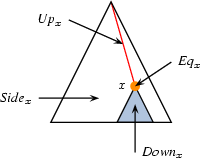4.3.1 Well-Formedness Constraints
Consider a solution tree for a description  . Further consider the node
. Further consider the node  , in that tree, interpreting variable
, in that tree, interpreting variable  occurring in
occurring in  . When observed from the vantage point of this node, the nodes of the tree (hence the variables that they interpret) are partitioned into 4 regions:
. When observed from the vantage point of this node, the nodes of the tree (hence the variables that they interpret) are partitioned into 4 regions:  itself, all nodes above, all nodes below, and all nodes to the side (i.e. in disjoint subtrees).
itself, all nodes above, all nodes below, and all nodes to the side (i.e. in disjoint subtrees).

The variables of  are correspondingly partitioned: all variables that are also interpreted by
are correspondingly partitioned: all variables that are also interpreted by  , all variables interpreted by the nodes above, resp. below or to the side. We introduce 4 variables to denote these sets:
, all variables interpreted by the nodes above, resp. below or to the side. We introduce 4 variables to denote these sets:
Clearly,  is one of the variables interpreted by
is one of the variables interpreted by  :
:
Furthermore, as described above, these sets must form a partition of the variables occurring in  :
:


